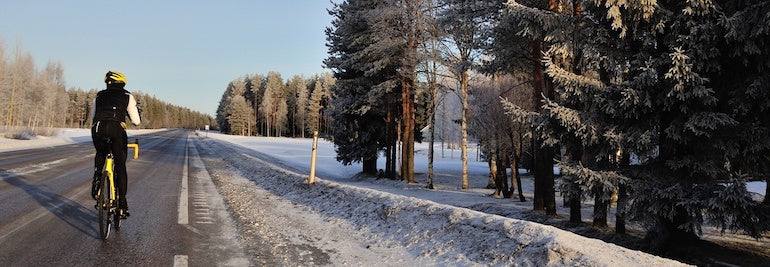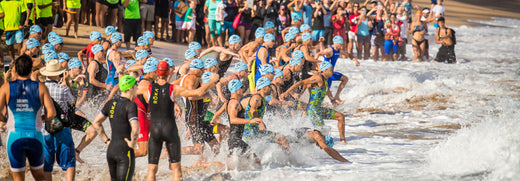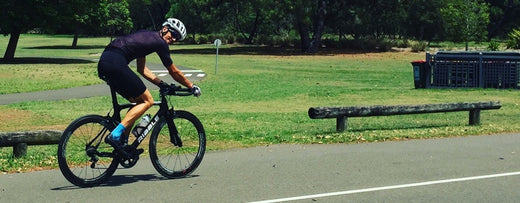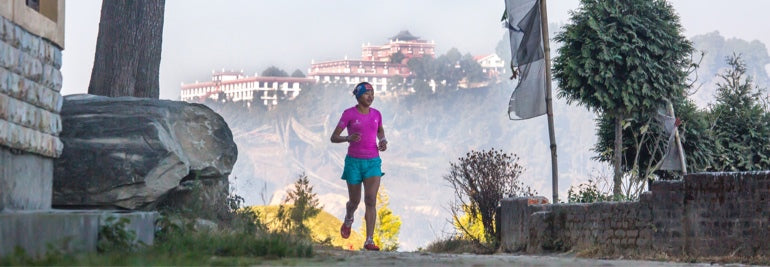

SUUNTOブログ

What you really need to know about winter cycling adventures
I train 5–6 days/week for a total amount of 5–600 km/week.
Not so impressive if you consider the normal activity of a pro rider, but that's winter conditions, under the rain or the snow, and usually includes about 8 - 10k of ascent per week. Last year I did 31.000 kilometers, between training, races and solo adventures.
My coldest ride saw temperature of -20 to -32°C.
It was the last stage of my 2016 Norwegian adventure. It was by far the coldest ride I’ve ever done.
Spikes and disk brakes are the way to go.
You need spiked tires – and disc brakes
For winter rides like the one I will do in Finland I use a Wilier Triestina Cross Disc Carbon, equipped with a Shimano Ultegra Disc Groupset and Mavic Disc Wheelset. I will use two kinds of tires: normal tires in case of standard conditions, and spiked tires in case of very icy roads. On my stem I will put my Suunto Spartan Ultra watch: I love recording the ride to analyse the performance and to see what I’ve done. But one of the most important things is disc brakes – I did my first Arctic adventure with normal brakes, and it was horrible.
Always listen your body
During my adventures I usually have a support car. They film my ride, and support me in case of an emergency. My girlfriend is an expert in first aid. The most important thing is to stop when you “hear” something strange from your body. During 2016 adventure in Norway, for example, I stopped for two hours because I simply lost all feeling in two fingers.
"Listen to your body," says Omar.
A standard day is 10–12 hours on the bike
I wake up to a good breakfast at 6. I’m on the road at 8. Somewhere between 18:00 and 20:00 I stop, have a good dinner, then check over the bike.
You’ve got to eat right
You need the best possible food to have enough energy – and in cold conditions, your consumption will be higher than ever. It’s a challenge for me -– and my support team too!
Follow along with Omar during his current Arctic challenge – cycling across Finland from South to North – at his Facebook page! So far he has covered 826 km on complicated icy road surfaces in four days.
READ MORE
Ultacycling man Omar Di Felice is heading straight north
The art of cycling around the world

Suunto and XTERRA team up for the Pan American Tour
“No two courses in the world are alike,” says Tom Kiely, XTERRA CEO. “Each a different experience. All are in nature. Mother Nature is your toughest competitor.” The courses are often wet, muddy, and unquestionably challenging, with events upcoming in Alabama, Colorado, Utah, and of course, XTERRA’s home turf, Hawaii. Competitors are known for being tough as nails and extremely dedicated. The most impressed Tom has been? “Had to be the lady who completed the Maui trail run on crutches.”
For XTERRA, it was Suunto’s position as an authentic and credible adventure brand that made the partnership work. “There’s great synergy between our two companies,” continues Tom. “XTERRA athletes are all about discovering unknown territory, challenging themselves to be the best, and embracing the community. Suunto is too, and its world-class ‘XTERRA-proof’ GPS watches offers exceptional mapping, training, and community features.”
Those features mean the real ones benefitting from the partnership are athletes themselves. As part of the alliance, Josiah Middaugh, the 2016 XTERRA Pan American Tour Champion, who wears Suunto to train and race, will be sharing his workouts, tips, and more with bi-monthly Middaugh Coaching Corner, presented by Suunto columns this season. Bryson White, Suunto’s brand manager for the Americas, says: “We’re looking to standardize XTERRA course maps, provide training content specific to upcoming events, host demo days, and inspire the XTERRA Tribe to get out and Live More.” Suunto’s XTERRA course maps will make routes easier to read and follow, and provide more information to racers with layers of data that show altitude profiles, 3D terrain flyovers, and in some cases, historical user-data analysis of what it takes to succeed on a given course. What does that mean? XTERRA athletes will be able to re-create course-like training situations on their own in preparation for the race – and use watch data to assess how they’re performing in those conditions.
Suunto representatives will be on-site to educate and engage with the off-road community at XTERRA Oak Mountain (May 20-21, Pelham, Ala.), XTERRA Beaver Creek (July 15, Avon, Colo.), XTERRA Pan Am Championship (Sept 16-17, Ogden, Utah), XTERRA World Championship (Oct. 29, Maui, Hawaii), and XTERRA Trail Run World Championship (Dec. 3, Kualoa Ranch, Hawaii) as well as other select races throughout the year.
Learn more about XTERRA at xterraplanet.com
READ MORE
Meet the endurance super-couple aiming to do 100 triathlons in 100 days
How to run a sub-3h marathon
3 must-run routes in New York City
Ultracycling man Omar di Felice is heading straight North
Over the last few years, Omar has pedaled through some unique, lonesome, incredible Arctic adventures – first 700km, then 1200km, then 1400km – and now, an even bigger goal: 1600km, or one thousand miles – finishing well above the Arctic Circle. He hopes to do it in just ten days, with one rest day – and make no mistake, it is not going to be easy. It’s waking up early, going hard, and then doing it all again, in freezing rain and blizzards, on top of asphalt, snow, and ice. This is not your average New Year’s Resolution.
What drives him to do this? Something much warmer than temps outside: passion. Says Omar: "(Ultra)cycling for me is a job, and a real challenge against myself, but I don’t forget that everything started as a game. The game of a boy who dreams to discover the world on his bike. To ride a bike in the winter is really amazing! Of course, you’ve to choose the right equipment and to pay attention more than during other seasons. But if you are so brave to ride in such cold conditions, you will discover a new world!”
This year’s adventure has a unique route: straight north, from Helsinki, Finland, to Nordkapp, Norway. It’s the first time Omar will cross a country, 100% from South to North – which suits his thirst for exploration. “I enjoy the ability to explore the world at the speed and in the manner I prefer," he says. "For example, in 2015, when I cycled from Paris to Rome (1600 km) nonstop, I passed by the Tyrrhenian Coast, through the Alps, and two countries in only 72 hours. Exploration is one of my considerations when I look for an extreme challenge.”
Extreme challenge indeed. So is it pure misery? Not at all. "A lot of people think that my adventures are only a suffering exercise. No! It’s a pleasure and a real amazing experience to put your wheels on the ice and the snow. When you cross an Arctic country during the winter you can see something special like the Arctic night and his magic silence, beautiful colours on the sky and, if you’re lucky, the Northern Lights."
His adventure starts January 30th, and you can be sure to check the Suunto Facebook page for some updates – or follow along at his Facebook page.
Tune in next week for some of Omar’s top tips on winter road biking!
READ MORE
MEET THE NOMAD WHO HAS CYCLED AROUND THE GLOBE FOUR TIMES
A FIVE-DAY BIKE RIDE AS A SINGLE FILE – WITHOUT RECHARGING THE AMBIT3 PEAK

Meet the endurance super-couple aiming to do 100 triathlons in 100 days
John and Debi are calling it the Iron Century. John is doing the full Ironman distance and Debi (who gave birth to their son Ryder only seven months ago!) aiming for the half. They’re aiming to complete the challenge on the day of the Ironman Australia, in Port Macquarie on May 7th – and qualify for the Ironman World Championships in Kona at the same time. Crazy? Absolutely. We had a quick chat to find out just how crazy they actually are.
Where did you get the idea? And what makes you think you can do it?
We owe much of the inspiration to the Iron Cowboy James Lawrence, who completed 50 Ironmans in 50 states in 50 days. We said if he can do that, with all the travel and logistics and planning that go into it, we can definitely do the same route 100 times in our backyard.
So it’s the exact same route, every day?
For the first 95 days, yes – we’ll start off in the Prince Alfred Pool, just a few kilometers away from the house. They’ve reserved us our own lane every morning.
And the bike and the run?
From the pool we’ll hop in the motorhome, and head to Centennial Park, just a kilometer from our house. A loop of the park is exactly 3.8kms. I’ll do 48 laps on the bike, while Debi will do 24, and then the run will be 12 laps for me, and 6 for Debi.
Sounds brutal. How fast?
100 days is a long time, but my natural rhythm is pretty quick, so I can’t go too slow. I’ll be aiming for about 12 hours, Debi six.
And you’ll have some company.
Yep – our 7-month-old son Ryder loves being pushed in the pram, and he’ll join us for a bit each day. We expect he’ll get about 7,000km in over the course of the project – but he’ll even have his own separate Suunto watch recording his adventures!
There’s been some incredible logistics in planning this.
Yep – there’s no question success is all about recovery here. Foodora will be delivering a hot meal to our house every evening, so we won’t have to cook. Local physio Healthspace has lined up a crew of massage therapists to treat us every day of the challenge.
And for the last five days?
So after day 95, we’ll hop in the motorhome and head up to Port Macquarie, where we’ll both compete in the Ironman Australia in hopes of qualifying for Ironman Worlds in Hawaii later this year.
All we can say right now is best of luck – stay tuned to the Suunto Facebook or the IronCentury Facebook page for the latest updates on John and Debi’s insane trip challenge!
READ MORE
7 tips to keep a balanced training load
The right way to qualify for Kona

Nepalese trail runner Mira Rai has been voted the People’s Choice Adventurer of the Year 2017
Mira Rai now joins the group of Suunto adventurers, like Kilian Jornet, Ueli Steck and Greg Hill, who have been nominated as the Adventurers of the year in the past.
We got in touch with Mira to hear the latest news.
Hey Mira, congratulations! You are now the 2017 People’s Choice Adventurer of the Year. How does it feel?
Wow! Amazing! I am very happy! I am very grateful for the support of everyone who supported.
What does this award mean to you?
It is very, very valuable for me. I had never thought I would win with top adventurers of the world in the competition. I am really thankful to everyone who has supported me and voted for me. I am very grateful to Trail Running Nepal, the director and everyone who worked behind the scenes to help me win this. This is not my win; this is an award for Nepal.
How are you going to celebrate this?
How will I celebrate? (laughs) I have not thought about celebrating! I want to thank everyone who has supported me. I think I will invite brothers and sisters for run/hike to one of the trails in Kathmandu at the weekend.
You organized a running race in your home-town last year. Why did you do it, how was it and are you organizing it again?
I wanted to introduce a trail race in my village, and let my village people experience what I do. I think organizing races and letting village kids have exposure to competitive running can inspire them to take athletics seriously if they are interested. I want to give the opportunity as I had had before. I also wanted to gain experience of organizing races.
My first race had 124 participants. Everyone from children to elders were excited to participate. Since it was raining that day, so many people who were interested couldn’t join. I am thankful to get support from various agencies. I was able to donate 90 pairs of goldstar shoes to the kids and they loved it. It was a successful race.
Yes, I want to organize it again. It is a very hard work. I will need more support.
Why do you think sport is important for women in Nepal?
Women living in the hills of Nepal are very strong. Many of them can carry heavy loads on technical trails without breaking a sweat. I think women should be encouraged to partake in sports in Nepal because like me, there can be many women who can make the country proud if given an opportunity.
What are your plans for this year? Some interesting projects or races coming up?
I want to focus on organizing trail races in Nepal this year with my Trail Running Nepal team. Also, I will be participating in races in China, France and Spain.
How have you recovered from the ACL injury you had last year?
My knee has not completely recovered. It might take another 3 or so months to fully recover. But I am working hard now doing physiotherapy, yoga, cross training to keep fit.
Images by Anuj Adhikary
For more info on running in Nepal, visit trailrunktm.com and trailrunningnepal.org
READ MORE
MEETING NEPALESE TRAIL RUNNER MIRA RAI
UELI STECK NOMINATED FOR ADVENTURER OF THE YEAR AWARD
KILIAN JORNET NAMED ADVENTURER OF THE YEAR

Alex Lindbloom takes over @SuuntoDive Instagram
Tell us about yourself:
My name is Alex and I'm an American underwater photographer who's been working in Indonesia for the last four years. I live on a boat that splits seasons between Komodo, Raja Ampat, and the Banda Sea. I dive every day with my camera in the ocean's most diverse reefs and I love my job!
Where do you like to dive?
My work keeps me diving year round in Indonesia and you could say that I like Indonesia quite a bit. The diversity of species/subjects and of types of diving are endless. If you are feeling a bit burnt out on macro for example, it's not hard to find some wide-angle subjects like mantas, mangroves, or stunning reefscapes. It's where I've learned to take pictures and can't imagine a better training ground.
What inspires you in the underwater world?
I find myself most inspired by the underwater world by the fact that there is no experience on land where you can be so incredibly immersed in nature as you can be underwater. On land, not even the boldest photographer would be caught running around as a pride of lions hunts a heard of wildebeest. They'd be destroyed, either by the lions or by the stampede. Yet, underwater you can quite literally be in the middle of a feeding frenzy of the oceans top predators and come out without a scratch, and some pretty incredible images. As a photographer, those types of encounters are what you live for.
How would you describe your photography style?
Until I find that subject that I really want to focus my attention and time on, I'm sort of like a golden retriever who's found a ball, a stick and a cat at the same time. I want it all but can only choose one at a time. I'd say that my style is a bit eclectic, which I think also has a lot to do with the wide range of subjects in Indonesia. I love wide-angle and playing with natural light but I do love the hunt for those funny little benthic critters.
Is there a story you wish to tell with your images?
There's always a story to tell with your images, though I believe that story may be read differently depending on the viewer despite what I had intended to say with that image. I always want my images to reflect the beauty and fragility of nature. Hopefully some of that is getting though and maybe it even inspires some change in people’s perspective of the natural world and the need to preserve it.
Follow @suuntodive and @alexlindbloomphoto to see more of Alex’s work!
Check out also Alex Lindbloom Film and Photography on Facebook and www.alexlindbloom.com. On his website Alex hosts underwater photo tutorials.
READ MORE
10 tips to take amazing underwater photos
William Trubridge talks record attempts and the art of freediving










































































